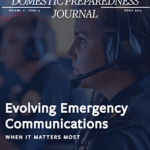The distribution of medical countermeasures (MCMs) has the potential to be one of the largest challenges a public health entity will have to face. The U.S. federal government recognizes the need for ensuring that MCMs are available to combat emerging infectious diseases, pandemics, and bioterrorist attacks. Homeland Security Presidential Directive (HSPD) 21, which focuses on Public Health and Medical Preparedness, articulates the overall strategic direction and focus of public health preparedness for the foreseeable future. More specifically, it focuses primarily on four key components of public health and medical preparedness: bio-surveillance, countermeasures distribution, mass-casualty care, and community resilience.
There also are two documents, issued since HSPD 21 was announced, that recognize the importance of MCM dispensing as a fundamental element of public health preparedness; those documents are the National Health Security Strategy (NHSS) and the Biennial Implementation Plan (BIP). In addition, the U.S. Department of Health and Human Services (HHS) conducted a review, in 2010, of the department’s MCM enterprise to ensure that the nation has in place, and follows, a forward-looking 21st century system. HHS recognizes that there are multiple components and organizations essential to the timely development, deployment, and use of MCMs, including providing critical investments in the public health system.
The Public Health Preparedness (PHP) Capabilities, released in March 2011 by the U.S. Centers for Disease Control and Prevention (CDC), defines MCM dispensing as “the ability to provide medical countermeasures (including vaccines, antiviral drugs, antibiotics, antitoxins, etc.) in support of treatment or prophylaxis (oral or vaccination) to the populationentified in accordance with public health guidelines and/or recommendations.” The PHP Capabilities document also outlines the required functions and performance measures of state and local public health entities in MCM dispensing, including but not necessarily limited to such responsibilities as the following:entifying and initiating MCM dispensing strategies; receiving MCMs; activating dispensing modalities; dispensing MCMs toentified populations; and reporting adverse events.
The Medical and Non-Medical Models for MCM Dispensing
The CDC’s Strategic National Stockpile (SNS) provides the national supply of medications and medical supplies needed for emergency situations. Those supplies are pre-positioned throughout the United States so that a “push-pack” (containing a cache of pharmaceuticals, antidotes, and medical supplies) can be deployed anywhere within the United States, and U.S. territories, within 12 hours after receipt of a request to re-supply state and local caches.
The general model followed is predicated on the assumption that the CDC will, upon notification of an emergency situation requiring SNS assets, distribute the medications to state health departments – which will then work in cooperation with local partners to ensure that the medications are dispensed to the exposed/populations that might have been infected. The most traditional method used by local health departments to dispense medications to their own populations is to use either of two types of Points of Dispensing Sites (PODs):
(1) Medical Model – Uses medical personnel as dispensers, but licensed medical personnel control the dispensing process. Patients are provided with an in-depth educational session about the threat, medication, and other applicable information. The documentation of patients is extensive, and medical assessments are available at the PODs. The medical model is most likely to be used in situations (e.g., pandemic influenza) and in areas where all residents must come to a POD, in person, to receive their vaccinations.
(2) Non-Medical Model – Primarily uses non-medical personnel (e.g., county staff, volunteers). Patients are provided minimal educational information, and are required to fill out only minimal documentation at the POD. The purpose of this model is to provide medications to the most people in the quickest way possible. The non-medical model is most likely to be used in circumstances that require the rapid distribution of medications (e.g., as required by the Cities Readiness Initiative [CRI] to ensure the prophylaxis of a population within 48 hours after receiving SNS assets). In this model – required primarily in situations such as a biological attack in which aerosolized anthrax is the toxic agent used – only one household representative is required to report to a POD in person to pick up medications for all members of his or her family.
Open & Closed PODs, Drive-Thrus, Pharmacies, and the USPS
Since the 2001 anthrax attacks and other nationwide and worldwide public health emergencies that followed since, the U.S. government has invested a significant amount of resources and funding to state and local public health agencies and organizations to ensure the effective and efficient dispensing of medications. Each department is required to have written plans that detail how it plans to dispense MCMs to affected populations, keeping in mind how dispensing may be altered based on the specific public health emergency involved, the resources available to the jurisdiction, and the time frame in which the medications must be provided to the population. Among the several ways in which MCM dispensing can be carried out are the following:
Open PODs – Dispensing sites that provide medication to the general population. Residents would be made aware of the location of these sites, as well as other specific information during a public health emergency, through pre-developed scripting and messages distributed by public health authorities via various media. This is the most traditional type of MCM dispensing, and is used in situations where a majority of the population will be provided medications.
Closed PODs – Dispensing sites that serve a discrete population – e.g., military bases, colleges/universities, major businesses, nursing homes, correctional facilities, or even faith-based organizations. These sites would not be available to the general public. The staffing and materials related to distribution are usually supplied by the site itself, while the medication and training are provided by public health entities under a Memorandum of Understanding (MOU). The use of Closed PODs in dispensing will help alleviate the staffing and resource strain on local jurisdictions, which may simultaneously be using open PODs and/or other methods of distribution. A key benefit of using Closed PODs is that they attend directly to their specific populations and ensuring their safety.
Drive-Thru PODs – Residents can receive prophylaxis without getting out of their cars, trucks, or other vehicles. This option has been exercised by many jurisdictions – through the use of drive-thru flu clinics, for example, where residents can simply drive to a specific location where they will be directed to pre-designated stations to: complete any paperwork necessary, receive additional information (if needed), and receive their vaccinations. The Drive-Thru method is beneficial when considering such complicating factors as inclement weather conditions and/or poor sanitation that might deter residents from going to a traditional Open POD. The Drive-Thru PODs also help reduce the spread of disease by limiting face-to-face contact among patients.
Pharmacies – This model was actually used by some jurisdictions during the H1N1 outbreak. Residents will go to a participating pharmacy and receive their prophylaxis directly from pharmacists and other trained staff. A drive-thru model may also be used by the pharmacy if the location can support it. As is done with a Closed POD, the pharmacies would supply the staff and materials, but medication and training would be provided by a public health entity through an MOU. This model can be used as either a Closed or Open POD.
The United States Postal Service (USPS) – Some jurisdictions plan to use volunteer postal carriers, through the CRI Program, for the delivery of prophylaxis directly to residents’ homes during a potential mass-casualty event. The USPS has developed the capability, experience, and knowledge required in delivering a broad spectrum of packages, letters, and other items throughout virtually all U.S. jurisdictions in a short period of time. This model admittedly presents certain challenges that other models may not – including, for example, the need to provide security for each of the postal workers involved. Many jurisdictions planning to use this model are doing so to help buy time while PODs are being set up, but usually not as a primary or sole dispensing model.
Partnerships, Volunteers, and Personal Responsibilities
No matter which mechanism is used to deliver MCMs, the partnerships between public health and federal, state, regional, and county agencies, first responders, private-sector businesses, non-profit organizations, and non-governmental organizations is critical. Law enforcement and fire agencies, emergency medical services (EMS) units, and homeland security/emergency management officials will be particularly important because all of them have specific roles to play in any model or type of MCM dispensing plan used. For example, law enforcement agencies probably will be used to help secure the transport of SNS assets and provide security at PODs.
Other local agencies, such as departments of transportation, and public schools (if PODs will be located at schools), also will be important in providing the resources and infrastructure needed to carry out MCM dispensing. Volunteers from the Medical Reserve Corps (MRC), Community Emergency Response Teams (CERTs), and other volunteer organizations will also play major roles in supplementing the staffing needs at PODs and other MCM dispensing locations.
In addition toentifying and planning with partners, the other critical elements of any MCM dispensing plan are assuring that: (a) all partners are aware of and trained for the plan; and (b) each individual understands his or her own duties and responsibilities. The plan also has to be exercised appropriately and often (through both discussion-based and operational-based exercises).
To briefly summarize: As discussed above, the possibility of having to dispense MCMs to a relatively large population, usually under austere working conditions, is one that has the potential to stress even the best prepared health department and entire jurisdiction. Understanding the various components that make up an effective MCM distribution plan, exercising on those plan elements, ensuring that the community has available a sufficient number of both open and closed PODs, and determining that partner agencies are fully aware of their responsibilities, are all foundational elements in determining the level of readiness needed to quickly and efficiently dispense needed and available MCMs.
____________
For additional information on the HHS review of their MCM enterprise, see: U.S. Department of Health and Human Services, The Public Health Emergency Medical Countermeasures Enterprise Review: Transforming the Enterprise to Meet Long-Range National Needs, August 2010.

Raphael M. Barishansky
Raphael M. Barishansky, DrPH, is a public health and emergency medical services (EMS) leader with more than 30 years of experience in a variety of systems and agencies in positions of increasing responsibility. Currently, he is a consultant providing his unique perspective and multi-faceted public health and EMS expertise to various organizations. His most recent position prior to this was as the Deputy Secretary for Health Preparedness and Community Protection at the Pennsylvania Department of Health, a role he recently left after several years. Mr. Barishansky recently completed a Doctorate in Public Health (DrPH) at the Fairbanks School of Public Health at Indiana University. He holds a Bachelor of Arts degree from Touro College, a Master of Public Health degree from New York Medical College, and a Master of Science in Homeland Security Studies from Long Island University. His publications have appeared in various trade and academic journals, and he is a frequent presenter at various state, national, and international conferences.
- Raphael M. Barishanskyhttps://domesticpreparedness.com/author/raphael-m-barishansky
- Raphael M. Barishanskyhttps://domesticpreparedness.com/author/raphael-m-barishansky
- Raphael M. Barishanskyhttps://domesticpreparedness.com/author/raphael-m-barishansky
- Raphael M. Barishanskyhttps://domesticpreparedness.com/author/raphael-m-barishansky

Audrey Mazurek
Audrey Mazurek, MS, has worked at all levels of government for nearly 20 years in public health and healthcare preparedness, emergency management, and homeland security. She was a program manager with the National Association of County and City Health Officials (NACCHO) Project Public Health Ready program. She supported the U.S. Department of Homeland Security in the development of an accreditation and certification program for private sector preparedness. She also served as a public health emergency preparedness planner for two local public health departments in Maryland, where she developed over 30 preparedness and response plans, trainings, and exercises. She is currently a director of public health preparedness with ICF, primarily supporting the U.S. Department of Health and Human Services, Assistant Secretary for Preparedness and Response’s (ASPR) Technical Resources, Assistance Center, and Information Exchange (TRACIE) program as the ICF program director.
- Audrey Mazurekhttps://domesticpreparedness.com/author/audrey-mazurek
- Audrey Mazurekhttps://domesticpreparedness.com/author/audrey-mazurek
- Audrey Mazurekhttps://domesticpreparedness.com/author/audrey-mazurek
- Audrey Mazurekhttps://domesticpreparedness.com/author/audrey-mazurek






